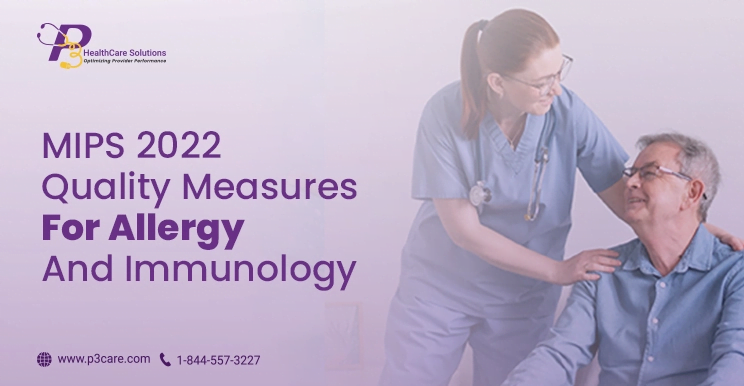

Each performance category accounts for a particular percentage of the overall score, which determines how much payment adjustment a clinician will receive for the following MIPS year’s performance.
The rules and regulations relating to each category also change or are updated every year.
So today, we will be discussing the MIPS Quality Measures linked to Allergy and Immunology.
Below, we will be providing brief explanations of the measures that specifically deal with the Allergy and Immunology specialty for the MIPS 2022 evaluation.
This category makes up 30% of the final score, and participants have to report six measures out of the available ones. At least one of the six measures has to be an outcome-based or high priority measure, and all of them have to be reported for 12 months.
This category deals with 12 to 20 years old adolescents who went to a primary healthcare provider for the following reasons:
| 2022 MIPS Measure no. 110 | ||
| Preventive Care and Early Detection: Immunization Against Influenza | This category is for six months or older patients who went to a clinic to get an influenza immunization or have shown an old receipt of previously getting immunized. It needs to be done anytime from the 1st of October to the 31st of March. | |
| 2022 MIPS Measure no. 111 | ||
| Pneumococcal Vaccination Status of Older Adults | It is for the 66 or older patients who have ever gotten the dose of the pneumococcal vaccine. | |
| 2022 MIPS Measure no. 111 | ||
| Pneumococcal Vaccination Status of Older Adults | It is for the 66 or older patients who have ever gotten the dose of the pneumococcal vaccine. | |
| 2022 MIPS Measure no. 130 | ||
| Documentation of Current Medications in the Medical Record of the Patient | It is a high priority measure, and it is for patients of age 18 or more who take multiple medications. Their doctor must attest to all their medication and document it in their medical file using the means available during their visit. | |
| 2022 MIPS Measure no. 130 | ||
| Documentation of Current Medications in the Medical Record of the Patient | It is a high priority measure, and it is for patients of age 18 or more who take multiple medications. Their doctor must attest to all their medication and document it in their medical file using the means available during their visit. | |
| 2022 MIPS Measure no. 226 | ||
| Preventive Care and Early Detection: Checking for Tobacco Use and Intervention for Ceasing | It is for patients aged 18 or more who:
| |
| 2022 MIPS Measure no. 238 | ||
| Use of High-Risk Medications in the Elderly | It is a high-priority measure for patients 65 and older who use at least two high-risk drugs. | |
| 2022 MIPS Measure no. 317 | ||
| Preventive Care and Early Detection: Checking for High Blood Pressure and Follow-Up Documentation | This category is for 18 and older patients who got check-ups for high blood pressure during the measurement period. If their result was pre-hypertensive or hypertensive, they had to come for a follow-up that got documented. | |
| 2022 MIPS Measure no. 331 | ||
| Adult Sinusitis: Treatment of Acute Viral Sinusitis with Antibiotics (For Overuse) | This is a high priority measure and it is for patients aged 18 or more, who got diagnosed with acute viral sinusitis and were given an antibiotic within 10 days of showing symptoms. | |
| 2022 MIPS measure no. 332 | ||
| Adult Sinusitis: Suitable Option of Antibiotic: Patients with Acute Bacterial Sinusitis who were prescribed Amoxicillin with or without Clavulanate (For Appropriate Use) | This is a high priority measure and it is for patients aged 18 or more, who got diagnosed with acute bacterial sinusitis and were prescribed amoxicillin for treatment. Amoxicillin could be with or without clavulanate. | |
| 2022 MIPS Measure no. 338 | ||
| Viral Load Suppression for HIV | It is a high priority measure for patients who have been diagnosed with HIV, regardless of age. And have had an HIV viral load of fewer than 200 copies per mL at their last viral load test during the current measurement year. | |
| 2022 MIPS Measure no. 340 | ||
| Medical Visit Frequency of Patients Diagnosed with HIV | It is a high priority measure for patients diagnosed with HIV, no matter their age. They must have had a medical visit every six months within the last 24-month measurement period, with a minimum of 60 days between each visit. | |
| 2022 MIPS Measure no. 374 | ||
| Receiving Patient’s Information from the Specialist and Completing the Referral Cycle | It is a high priority measure for the patients who come to a new healthcare provider with a referral from their old one. Regardless of their age, the new provider will receive information about them from the previous one. | |
| 2022 MIPS Measure no. 398 | ||
| Optimal Management of Asthma | It is a high priority measure and a cumulative evaluation of adult and pediatric patients with well-controlled asthma that is not at the risk of becoming worse. This was determined by one of the three age-appropriate patient-reported measure outcome (PROM) tools. | |
| 2022 MIPS Measure no. 402 | ||
| Harmful Use of Tobacco in Adolescents and Getting Them to Quit | This category deals with 12 to 20 years old adolescents who went to a primary healthcare provider for the following reasons:
| |

In MIPS 2022 reporting, this category makes up 25% of the final score. All participants have to submit data for the measures for a minimum of 90 days. If you are using EHR Technology of the 2015 edition, it must be in place by October 3, 2021.
In Case of Exception
If you are eligible for an exception from this category, then its 25% will be reweighed to the Quality performance category, making it hold 65% of the total score.
The measures of this performance category relevant to Allergy and Immunology are:

In 2022, this category makes up 15% of the total MIPS score. Participants need to attest that they completed either two high-weighted or four medium-weighted activities for a minimum of 90 days.
There are a few reasons you can get an exception from reporting the set number of activities. Such as,
In these cases, you can attest to one high-weighted or two medium-weighted activities for a minimum of 90 days.
Also, a group can attest to an activity if at least 50% of the clinicians in the group perform it for a continuous 90-day period in the same performance year.

There are over 100 measures to choose from, and here are a few options relevant to the Allergy and Immunology specialty.

